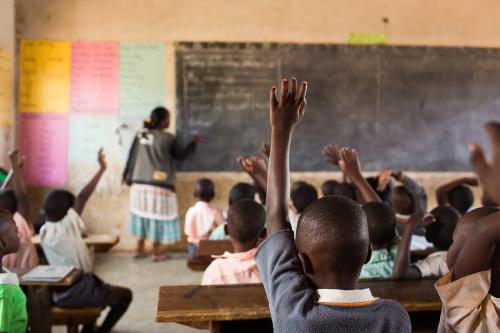This foundational summary report has seven companion case studies—Iowa BIG, USA, the International Baccalaureate, Ireland, India, British Columbia, Chile, and Singapore. All case studies bear remarkable similarities in their efforts to (re)build education systems—each is working in policy contexts pressing for academic quality and equity, while also facing additional incentives to support holistic student development.
The period since the founding of the United Nations Educational, Scientific, and Cultural Organization (UNESCO) in 1945 has been marked by an accumulating global agenda for transforming education for students in fundamental ways—including the recognition that education is a human right and a public good, that access is not tantamount to learning, and that academic learning is but one dimension of holistic student development (Figure 1). Each of these calls for global educational transformation has been invoked in response to crises regarding educational equity, quality, and purpose. These crises have been underscored by the COVID-19 pandemic, which brought the needs of the whole child to the forefront.
The global education policy arena is a crowded space, with many interests and voices competing for priority in motivating and framing agendas for improvement and innovation. In search of common ground, this report centers on two critical questions that should be matters of universal concern.

The first question is rhetorical, aiming to engage both heart and mind in considering efforts to build and rebuild academically focused education systems into humanistic education systems that also support the social, emotional, moral, and civic development of students:
What would it mean—and what would it take—to build education systems that develop every child as would that child’s own parents?
The second question is empirical, aiming to draw a diverse global audience into productive, evidence-informed conversation about complex and contentious issues of collective interest, one central issue being potential synergies between the pursuits of academic and holistic student development:
Is there evidence that it is even possible to (re)build academically focused education systems to support holistic student development?
The focus
In anticipation of the United Nations Transforming Education Summit in September 2022, this report explores the work of building and rebuilding education systems to support holistic student development. It focuses specifically on the journeys of seven education systems—situated in high-, middle-, and low-middle-income countries with democratic traditions—as they make the whole child the center of their work. They include national initiatives in Singapore, Ireland, and Chile; provincial, territorial, and local initiatives in Canada, India, and the United States; and a cross-national initiative in the International Baccalaureate. All seven systems operate in policy contexts pressing for measurable gains in students’ academic learning, and none seeks to compromise academic rigor. Yet all seven aim to go further by supporting the intellectual, physical, emotional, social, cultural, and moral development of students.
These are initiatives in which multiple stakeholders, in different positions and from different perspectives, are recognizing and heeding aspirations and logics, making meaning and sense, assuming agency and taking action, experiencing and learning, and adapting and coordinating. Indeed, in the work of building and rebuilding education systems, these initiatives also function as learning systems that produce the knowledge and capabilities needed to do all of these things, and more.
The findings
While different in many ways, the seven systems bear remarkable similarities in their efforts to (re)build education systems to support holistic student development. Each is working in policy contexts pressing for academic quality and equity while also facing additional incentives to support holistic student development.
Moreover, in these seven systems, efforts to (re)build education systems for holistic student development bear remarkable similarity to system (re)building for academic development, though imbued with new concern for moral legitimacy and responsibility alongside established concern for pragmatic legitimacy and technical effectiveness.
In these seven systems, education system building is multifaceted and involves 10 key lessons across three interrelated domains or forms of common work. Indeed, among the primary contributions of this report is a practical framework to guide diverse stakeholders in working together to transform education systems.
These seven systems work to manage their environments to build support for holistic student development among diverse stakeholders; address different institutional, cultural, and technical demands; and build partnerships for supporting reform. In so doing, they offer these key lessons for managing environments:
- Engage diverse stakeholders: Engage and coordinate among diverse stakeholders and leverage partnerships.
- Construct coherence: Create opportunities for diverse stakeholders to deliberate on different cultural norms, cognitive frameworks, and regulatory environments that inform schooling.
- Manage equity-and-rigor tension: Engage the perceived tensions between equity and rigor in deliberation about holistic development.
These systems also work to build or rebuild an educational infrastructure to enable approaches to instruction that can support holistic student development in schools. The following lessons are key for (re)building educational infrastructures for holistic student development:
4. Build social infrastructure: Build a social infrastructure that engages stakeholders about holistic student development and the entailments for instruction.
5. Develop instructional designs: Develop instructional designs that recognize and support instruction as a coproduction between students and teachers.
6. Design educational infrastructure: Design educational infrastructure to support new visions for instruction, and mobilize this infrastructure to support instructional improvement.
Finally, these systems work to integrate educational infrastructure with everyday practice in schools and classrooms. Their work highlights the following lessons:
- Balance common conventions with local discretion: Balance common systemwide conventions with the need for local discretion to promote and encourage reform.
- Distribute leadership: Develop and distribute leadership for instruction by, among other things, cultivating educator and student agency.
- Support infrastructure use: Support the use of educational infrastructure in school and classroom practice through professional learning.
- Monitor practice and performance: Conduct consistent, ongoing monitoring of practice and performance for continuous improvement and professional learning.
The domains of system-building work are interrelated and overlapping, involving continual attention to constructing coherence as institutional environments are in constant flux. Further, the work of different domains does not happen in any particular order: although managing environments is important early in a reform journey to build support for holistic student development, it remains just as crucial later in the journey.
These three domains of education system building played out consistently in initiatives that otherwise varied in terms of the level of operation (cross-national, national, provincial, territorial, or local); their unique historical, societal, and policy contexts; and their different approaches to supporting holistic student development. Moreover, in no case did these seven systems put digital or information technologies in the first position as primary drivers of educational transformation, as efficient, quick alternatives to the difficult, long-term work of institution building. Rather, each placed instruction—the collaborative work of teachers and students—in the first position, and each engaged deeply in the development of infrastructures and organizations to support holistic student development at a large scale.
Considerations for collective conversation and action
Our findings provide high-level perspective on complex, large-scale systems transformation. Further research is needed to examine how the work of system (re)building is playing out throughout these seven systems, how those doing the work are managing successes and challenges, and how the work is bearing on the daily lives of students and teachers. Moreover, further research is needed across countries at varying levels of development—especially in low-income countries striving to increase access to schooling and to establish institutions supporting foundational literacy and numeracy, all while managing the dire consequences of the COVID-19 pandemic and climate change.
Even so, these portraits of system (re)building toward holistic student development across the seven case studies present educators, policymakers, and researchers with key initial lessons for undertaking this work. The systems take diverse on-ramps and multiple pathways toward holistic student development. Their points of departure and connection suggest that critical leverage points enable forward movement as they take moral, technical, and institutional cues from the larger environment.
A large part of managing the environment will be for systems to explicitly connect technical values for educational quality and equity with moral values for holistic student development, deliberating on and negotiating dilemmas with diverse stakeholders. Nurturing teaching and learning for holistic student development will take not only ambitious vision and goals but also education system building and rebuilding efforts to support everyday practice. If the goals are ambitious, so too must be the infrastructures for supporting their enactment. Infrastructure use in everyday school and classroom practice must be deliberately cultivated and supported.
With these lessons in mind, we encourage diverse stakeholders in systems to engage in collaborative conversations and action centered on the three domains of practical framing for systems transformation that have emerged from our exploration:
- Manage environments and relationships.
- Build educational infrastructure.
- Integrate educational infrastructure in practice.
Supporting diverse stakeholders in doing this work, in turn, will depend on researchers’ continuing exploration of diverse system transformation efforts—especially in systems being pressed to support holistic student development while also striving to increase access and support foundational learning. It will involve developing new types of collegial, global learning and networking among system leaders at all levels. And it will require developing creative new ways to draw local education professionals, parents, community members, and students into cross-national learning opportunities that create new possibilities, build their knowledge and capabilities, and fuel their agency. For—as captured by the journeys of the seven systems explored here—much of the burden of transforming education systems rests on the shoulders of local education professionals, parents, community members, and students.
-
Acknowledgements and disclosures
Names of the primary authors are listed in alphabetical order. The primary authors contributed equally to this report. Juan Bravo, Whitney Hegseth, Jeanne Ho, Devi Khanna, Dennis Kwek, Angela Lyle, Amelia Peterson, Thomas K. Walsh, Jose Weinstein, and Hwei Ming Wong all contributed sections to this report.









